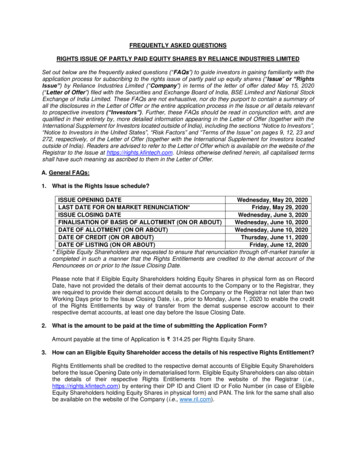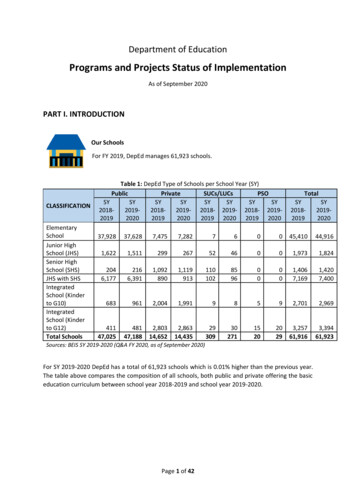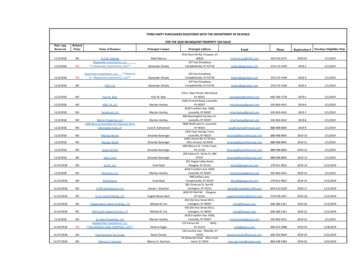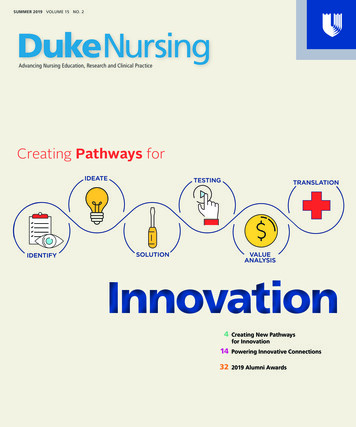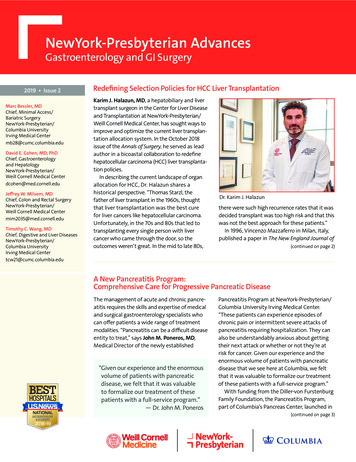
Transcription
NewYork-Presbyterian AdvancesGastroenterology and GI Surgery2019 Issue 2Marc Bessler, MDChief, Minimal Access/Bariatric SurgeryNewYork-Presbyterian/Columbia UniversityIrving Medical Centermb28@cumc.columbia.eduDavid E. Cohen, MD, PhDChief, Gastroenterologyand HepatologyNewYork-Presbyterian/Weill Cornell Medical Centerdcohen@med.cornell.eduJeffrey W. Milsom, MDChief, Colon and Rectal SurgeryNewYork-Presbyterian/Weill Cornell Medical Centermim2035@med.cornell.eduTimothy C. Wang, MDChief, Digestive and Liver DiseasesNewYork-Presbyterian/Columbia UniversityIrving Medical Centertcw21@cumc.columbia.eduRedefining Selection Policies for HCC Liver TransplantationKarim J. Halazun, MD, a hepatobiliary and livertransplant surgeon in the Center for Liver Diseaseand Transplantation at NewYork-Presbyterian/Weill Cornell Medical Center, has sought ways toimprove and optimize the current liver transplantation allocation system. In the October 2018issue of the Annals of Surgery, he served as leadauthor in a bicoastal collaboration to redefinehepatocellular carcinoma (HCC) liver transplantation policies.In describing the current landscape of organallocation for HCC, Dr. Halazun shares ahistorical perspective. “Thomas Starzl, thefather of liver transplant in the 1960s, thoughtthat liver transplantation was the best curefor liver cancers like hepatocellular carcinoma.Unfortunately, in the 70s and 80s that led totransplanting every single person with livercancer who came through the door, so theoutcomes weren’t great. In the mid to late 80s,Dr. Karim J. Halazunthere were such high recurrence rates that it wasdecided transplant was too high risk and that thiswas not the best approach for these patients.”In 1996, Vincenzo Mazzaferro in Milan, Italy,published a paper in The New England Journal of(continued on page 2)A New Pancreatitis Program:Comprehensive Care for Progressive Pancreatic DiseaseThe management of acute and chronic pancreatitis requires the skills and expertise of medicaland surgical gastroenterology specialists whocan offer patients a wide range of treatmentmodalities. “Pancreatitis can be a difficult diseaseentity to treat,” says John M. Poneros, MD,Medical Director of the newly established“ Given our experience and the enormousvolume of patients with pancreaticdisease, we felt that it was valuableto formalize our treatment of thesepatients with a full-service program.”— Dr. John M. PonerosPancreatitis Program at NewYork-Presbyterian/Columbia University Irving Medical Center.“These patients can experience episodes ofchronic pain or intermittent severe attacks ofpancreatitis requiring hospitalization. They canalso be understandably anxious about gettingtheir next attack or whether or not they’re atrisk for cancer. Given our experience and theenormous volume of patients with pancreaticdisease that we see here at Columbia, we feltthat it was valuable to formalize our treatmentof these patients with a full-service program.”With funding from the Diller-von FurstenburgFamily Foundation, the Pancreatitis Program,part of Columbia’s Pancreas Center, launched in(continued on page 3)
Advances in Gastroenterology and GI SurgeryRedefining Selection Policies for HCC Liver TransplantationMedicine defining criteria to select patients. The Milan criteriaset clear guidelines for which patients with HCC benefit fromtransplant with an acceptable recurrence-free survival. Thesecriteria were adopted globally by several transplant authoritiesto prioritize or even preclude liver transplant for patients withHCC.“The Milan criteria include a single tumor less than or equalto 5 cm, or up to three tumors, none of which are larger than3 cm,” says Dr. Halazun. “If the patient is within those criteria,the recurrence free survival rate approaches 90 percent at fiveyears. Basically, those criteria were based on 35 patients inMilan. It was a small sample size, but the impact was enormous.”According to Dr. Halazun, before the Milan criteria wereadopted in 2002, 2 percent of liver transplants were done forHCC – about 1,500 to 2,000 transplants. Since then, about athird – 30,000 out of 90,000 adult transplants – have beenperformed for HCC. “It’s a huge shift in volume because ofthese criteria and because the outcomes are so good,” he says.“These patients are also relatively easy to transplant, andthey do well.”HepatocellularcarcinomaThe Model for End-Stage Liver Disease, or MELD, a scoringsystem for assessing the severity of chronic liver disease, isnow used by the United Network for Organ Sharing (UNOS) forprioritizing allocation of liver transplants. As Dr. Halazunexplains, “Patients with HCC don’t have high MELD scores, sothey are given an ‘exception’ score based on if they are withinthese criteria. They start at 28 points and ultimately go up to acap of 34 points. In some parts of the country, that means theyget transplanted as soon as they get on the list and are giventhe points. In New York it means that patients can wait ninemonths to a year to get transplanted. The questions we askedwere: 1) Are we giving them too much priority and 2) Are weexcluding patients who have tumors that are outside thesecriteria? What we found (in a previous publication) is thatpatients who waited longer actually did better, which iscounterintuitive from a cancer standpoint. As a result, UNOSchanged its policy to implement a six-month waiting rule atwhich time points are assigned.”A Bicoastal CollaborationDr. Halazun and his colleagues began to look at redefining thecriteria, and, indeed, they were not alone in this endeavor.2(continued from page 1)“There have been many papers that showed the Milan criteriaare not the best way to select patients – even the author ofMilan has suggested several other criteria,” says Dr. Halazun,who in 2018 joined in this effort with liver transplant colleaguesat NewYork-Presbyterian/Columbia, Mount Sinai Medical Center,and the David Geffen School of Medicine at UCLA.According to the investigators, despite the utility andreproducibility of the Milan criteria, they have been criticizedfor their restrictiveness, and more importantly, for the lack oftumor biological indices to help dictate best oncologicalpractice when transplanting HCC patients.Using Serial AFP to Predict OutcomesDr. Halazun and the research team developed criteria thatinclude tumor biological indices, such as alfa-fetoprotein (AFP),to predict outcome. “AFP has long been recognized as a“ What we found with this study is that incorporatingAFP response is not only predictive of outcome, butit tells us who we should include who are outside ofthe criteria that would have very good survival.”— Dr. Karim J. Halazunbiological predictor of prognosis in HCC and has been centralto many of the new models developed for the transplantsetting,” says Dr. Halazun. “Unfortunately, many systems haveused AFP at a single time point even though patients usuallywait many months for transplantation during which timeneoadjuvant therapies are administered.”The researchers hypothesized that the response of AFP overtime serves as a better predictor of recurrence and survival andsought to investigate the importance of a dynamic AFP responsethrough their study of 1,450 adult patients undergoing livertransplant for HCC between January 2001 and December 2013at NewYork-Presbyterian, Mount Sinai, and UCLA. AFP responsewas measured as differences between maximum and finalpre-liver transplant AFP.The researchers concluded that “incorporating AFP responseover time into HCC selection criteria allows for the expansion ofthe Milan criteria. As UNOS considers adding AFP to selectionalgorithms, the NYCA score provides an objective, user-friendlytool for centers to appropriately risk-stratify patients.”“What we found with this study is that trending AFP is notonly predictive of outcome, but it tells us who outside of thecriteria would have very good survival. These are people whowould traditionally not get transplanted in many centers butwho actually could be transplanted,” says Dr. Halazun. “If theyhad been transplanted, they would have had upwards of a70 percent five-year recurrence-free survival.”(continued on page 6)
Advances in Gastroenterology and GI SurgeryA New Pancreatitis Program: Comprehensive Care for Progressive Pancreatic Disease (continued from page 1)Dr. John M. PonerosTotal removal of the pancreas results in the likely developmentof diabetes. During the pancreatectomy, the surgical teamremoves the pancreas, isolates the insulin-secreting islet cells, andthen injects the islet cells into the patient’s liver, where, hopefully,they take root and continue to produce insulin. “Removing thewhole pancreas significantly improves or even eliminates the painin over 90 percent of patients who undergo the procedure,” saysDr. Schrope. “And, while islet cell transplantation may enable thepatient to continue producing isulin, the procedure is not alwayssuccessful. A third of patients will make some insulin, but theywill still need to take insulin. Another third will be insulin free forsome time – four years, seven years, 10 years – but eventuallythe islets will fail and then the patients will become diabetic.But one-third of the time the procedure won’t work at all – thepancreas has been too damaged, the islet cells don’t engraft, andthe patients don’t make any insulin appreciably.”Dr. Schrope tries to perform a surgery that is short of a totalpancreatectomy, if possible. “Can I take only part of the pancreas,”she asks, “or can I just reroute the pancreas depending on whatthe anatomy looks like so that we can save the pancreas tokeep those islets working.”Dr. Beth A. Schrope2018 under the leadership of Dr. Poneros and Beth A. Schrope,MD, PhD, Surgical Director. As a major referral center for otherhospitals, the Columbia team frequently accepts patients withcomplex disease requiring tertiary care. “We’re able to offermultidisciplinary care for these patients that is not as easilyavailable at other institutions, for example, a patient withnecrotizing pancreatitis who requires invasive treatment, or apatient with a fever who is not responding to antibiotics andhas a significant amount of inflammation in their abdomen,”says Dr. Poneros. “We’re able to accept these patients fortransfer and help provide a better outcome.”The program offers minimally invasive treatment approachesthat include endoscopic cystogastrostomy and endoscopicnecrosectomy for patients that previously would have undergone open surgery in order to remove infected necrotic tissue.In addition to the latest medical, endoscopic, and surgicaltreatments, and nutritional support, genetic testing is availablefor patients with idiopathic recurrent acute pancreatitis. “Withgenetic testing and cutting-edge endoscopic imaging capabilities,we’re able to go that extra mile in figuring out whether there’s anintervenable etiology to their pancreatitis,” explains Dr. Poneros.“Often there will be an unrecognized mutation that might becontri buting to the patient’s symptoms. We also convene aweekly multidisciplinary conference to review all of our complicated pancreatic cases, which is attended by surgeons, radiologists,oncologists, radiation oncologists, and other pancreatologists.”Hematoxylin and eosinstain of sample fromislet chamber. Freeislets are dark red;acinar tissue debris islighter yellow.Dr. Poneros and Dr. Schrope collaborate on the treatmentplan of each patient, taking into account the etiology of thepancreatitis when recommending specific therapies. “If it’s dueto alcohol and you know that the patient has stopped drinking,hopefully they won’t get any more pancreatitis and there’s noneed to operate,” says Dr. Schrope. “Sometimes it’s a sequellaof one very bad attack of acute pancreatitis from gall stonesthat results in scarring of the pancreas. There is also autoimmune pancreatitis, a rare entity thought to be caused by thebody’s immune system attacking the pancreas. Hyperlipidemiais another cause.”Of all the patients for which Dr. Schrope has performed totalpancreatectomy and auto islet transplantation, hereditarypancreatitis is a factor in about 30 percent. “In certain types ofgenetic pancreatitis there is a significantly increased risk ofgetting pancreatic cancer, so we work that into our treatmentplan,” she says. “If the patient has the PRSS1 gene defect, forexample, there is about a 10-fold increased risk of pancreaticcancer. Even before islet cell therapy became popular, wewould remove the pancreas in these cases to avoid pancreaticcancer in the future. And now with islets, as long as we’re fairlyreassured that the patient has a benign disease, we can takeWhen Surgery is Necessary:Total Pancreatectomy and Auto Islet Transplantation“My philosophy is that surgery for chronic pancreatitis is thelast stop,” says Dr. Schrope, who is among some 20 surgeons inthe country – and who was the first in Manhattan – to performtotal pancreatectomy with autologous islet cell transplantation.“I recommend surgery only after other nonsurgical therapieshave been exhausted. Nutritional management and endoscopictherapies can be very useful in patients with this disease. Iwant all of these things to have been tried prior to consideringsurgery, and then my approach is as long as we can relieve thepatient’s pain, let’s keep as much of the pancreas as possible.”(continued on page 4)3
Advances in Gastroenterology and GI SurgeryMajor Faculty Expansion in Gastroenterology and GI Surgery (continued from page 5)GastroenterologyHepatologyRavi Sharaf, MD, MSElizabeth X. Zheng, MD(212) 746-4014 ras9030@med.cornell.edu(212) 305-0914 exz2001@cumc.columbia.edu Clinical cancer genetics Hereditary GI cancer syndromes Health services research Acute and chronic liver disease Liver cancer Transplant hepatologyDebbie Bakes, MDDeborah S. Keller, MD(212) 342-1155 db3023@cumc.columbia.edu(212) 342-1155 dsk2101@cumc.columbia.edu Laparoscopic, robotic and minimally invasivecolorectal surgery Management of anorectal conditions Management of pelvic floor disorders Anorectal procedures Laparoscopic, robotic andminimally invasive colorectal surgery Colonoscopy Management of pelvic floor disordersGastroenterology and HepatologyNewYork-Presbyterian/Weill CornellDigestive and Liver ctal SurgeryNewYork-Presbyterian/ColumbiaBrendan M. Finnerty, MDEndocrine SurgeryNewYork-Presbyterian/Weill Cornell(212) 746-5130 bmf9002@med.cornell.edu Endocrine and neuroendocrine surgicaloncology Minimally invasive surgery Robotic surgeryDaniel P. Geisler, MDColorectal SurgeryNewYork-Presbyterian/ColumbiaJ. Mark Kiely, MDColorectal SurgeryNewYork-Presbyterian/Columbia(212) 342-1155 jmk2270@cumc.columbia.edu Robotic rectal cancer surgery Crohn’s disease andinflammatory bowel disease Sphincter-sparing anal fistula surgeryColorectal SurgeryNewYork-Presbyterian/Columbia(212) 342-1155 dpg2122@cumc.columbia.edu Minimally invasive colorectal surgery Multimodality treatment of low andunfavorable rectal cancers Least-invasive surgery for ulcerative colitisA New Pancreatitis Program: Comprehensive Care for Progressive Pancreatic Disease (continued from page 3)out the pancreas and give the patient their islet cells at least totry to avoid the diabetes.”“We’re realizing that we need to be aggressive with progressivepancreatic disease, rather than accepting the notion thatthere’s not much to offer these patients in terms of stoppingthe march to chronic pancreatitis and potentially pancreaticcancer,” adds Dr. Poneros. “Our goal is to intervene to helpstem that tide, whether it’s endoscopically, medically, surgically,or one day, genetically. We want referring physicians to knowthat we have the resources and the expertise to help themmanage these very challenging patients.”Reference ArticlesGuo A, Poneros JM. The role of endotherapy in recurrent acutepancreatitis. Gastrointestinal Endoscopy Clinics of North America.2018 Oct;28(4):455-76.Schrope B. Total pancreatectomy with autologous islet cell transplantation. Gastrointestinal Endoscopy Clinics of North America.2018 Oct;28(4):605-18.For More InformationDr. John M. Poneros jmp14@cumc.columbia.eduDr. Beth A. Schrope bs170@cumc.columbia.edu4
Advances in Gastroenterology and GI SurgeryMajor Faculty Expansion in Gastroenterology and GI SurgeryNewYork-Presbyterian/Weill Cornell Medical Center and NewYork-Presbyterian/Columbia University Irving Medical Centerhave enhanced the breadth and depth of their gastroenterology, hepatology, and GI surgery programs with the appointmentof new faculty who bring a wide range of experience and expertise in multiple specialties.GastroenterologyAndrea Betesh, MDDana J. Lukin, MD, PhD(646) 962-5308 anb9279@med.cornell.edu(212) 746-5077 djl9010@med.cornell.edu Hereditary GI cancer syndromes Gastrointestinal cancers General gastroenterology Crohn’s disease Ulcerative colitis Pediatric IBD transition careJennifer Caceres, MDSriHari Mahadev, MD, MS(212) 932-4534 jc4874@cumc.columbia.edu(646) 962-2382 srm9005@med.cornell.edu General gastroenterology Liver disorders Video capsule endoscopy Advanced endoscopy Early esophageal, gastric, and colonicneoplasms Pancreatic and biliary diseaseAkash Goel, MDSaurabh Mukewar, MB, BSGastroenterology and HepatologyNewYork-Presbyterian/Weill CornellDigestive and Liver ogy and HepatologyNewYork-Presbyterian/Weill CornellGastroenterology and HepatologyNewYork-Presbyterian/Weill CornellGastroenterology and HepatologyNewYork-Presbyterian/Weill CornellGastroenterology and HepatologyNewYork-Presbyterian/Weill Cornell(646) 962-4000 akg9005@med.cornell.edu(646) 962-2382 mss9022@med.cornell.edu General gastroenterology Nutrition and integrative health Obesity and weight management Advance endoscopy Cancer of the liver, bile duct, and pancreas Polyps and subepithelial lesionsSusana Gonzalez, MDCarolyn Newberry, MDGastroenterology and HepatologyNewYork-Presbyterian/Weill CornellGastroenterology and HepatologyNewYork-Presbyterian/Weill Cornell(212) 746-4014 sug9009@med.cornell.edu(646) 962-4000 can9054@med.cornell.edu Gastroesophageal disorders Gastrointestinal cancers Pancreas disorders General gastroenterology Obesity and weight management Nutritional disorders and food intolerancesAnnMarie Kieber-Emmons, MDKartik Sampath, MDGastroenterology and HepatologyNewYork-Presbyterian/Weill CornellGastroenterology and HepatologyNewYork-Presbyterian/Weill Cornell(646) 962-4000 alk2059@med.cornell.edu(646) 962-2382 kas9280@med.cornell.edu Hereditary GI cancer syndromes Gastrointestinal cancers General gastroenterology Advanced endoscopy Esophageal disease Liver disease(continued on page 4)5
The following indicias atypeset by the pre-presNew York’s #1 Hospitalpiece. Since postal requ18 Years in a Rowof your mailing panel tapproval prior to prin Advances in Gastroenterology and GI SurgeryCOSMOS COMMUNICANewYork-Presbyterian Hospital525 East 68th StreetNew York, NY 10065NONPROFITORGANIZATIONU.S. POSTAGEPAIDL.I.C., NY 11101PERMIT NO. 375www.nyp.orgFIRSTU.SL.I.CPERPROMPT MAILING HOUNONPROFITORGANIZATIONU.S. POSTAGEPAIDSTATEN ISLAND, NY 10304PERMIT NO. 169BOUND PRINTEDMATTERU.S. POSTAGEPAIDSTATEN ISLAND, NYPERMIT NO. 169FIRSTU.SSTATEPERMPRESOPRINTU.SSTATEPERMDATAPRO MAILERS INDPRSRT-STDU.S. POSTAGEPAIDBRIDGEPORT, CTPERMIT NO. 347Redefining Selection Policies for HCC Liver Transplantation“Some people argue that we’re doing too many transplantsfor patients with HCC versus other patients, but I argue thatwe’re not doing enough,” continues Dr. Halazun. “We can givethem an excellent, long-term survival, and they can do verywell compared to many other diseases where we do transplant.The evolution will happen because the number of patientswith hepatocellular carcinoma is rising. We have to figure outhow we can give these patients a chance for a cure. Right nowwe’re doing operations for patients with other cancers wherethe survival at five years is under 25 percent. While those arenot liver transplants, even with those potentially bad resultswe still offer surgery to patients with the slim chance of cure.(continued from page 2)So, why not offer someone a transplant with a 70 percentchance of a cure?”Reference ArticleHalazun KJ, Tabrizian P, Najjar M, Florman S, Schwartz M,Michelassi F, Samstein B, Brown RS Jr, Emond JC, Busuttil RW,Agopian VG. Is it time to abandon the Milan criteria? Results of abicoastal U.S. collaboration to redefine hepatocellular carcinomaliver transplantation selection policies. Annals of Surgery. 2018Oct;268(4):690-99.For More InformationDr. Karim J. Halazun kah7007@med.cornell.edu6
Gastroenterology and GI Surgery 2019 Issue 2 Marc Bessler, MD Chief, inimal ccess/ Bariatric urgery NewYork-Presbyterian/ Columbia niversity Irving edical enter mb28@cumc.columbia.edu David E. Cohen, MD, PhD Chief, astroenterology and epatology NewYork-Presbyterian/ Weill ornell edical enter dcohen@med.cornell.edu Jeyrey W. Milsom, MD






